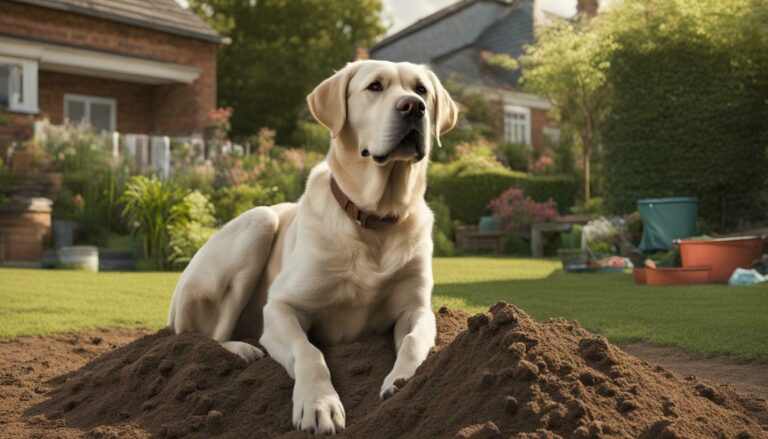
If you’re the proud owner of a Labrador, you may be wondering how big your furry friend will eventually get. Knowing what to expect in terms of size and weight can help you plan your dog’s diet, exercise routine, and other aspects of their care. In this comprehensive guide, we’ll explore everything you need to know about Labrador size and growth.
We’ll cover the different stages of Labrador growth, the average size and weight ranges for the breed, and the factors that can influence a Labrador’s final size. Whether you’re a new dog owner or a seasoned Labrador enthusiast, this guide will provide valuable information to help you understand your dog better.
Key Takeaways
- Labradors can grow to be quite large, but their size can vary based on factors like genetics, nutrition, and exercise.
- Understanding the different stages of Labrador growth can help you gauge your dog’s potential size and plan their care accordingly.
- The average size and weight range for Labradors fall within a specific range, but individual factors can cause significant variation.
- Genetics plays a crucial role in determining a Labrador’s size, so it’s essential to research your dog’s lineage before adopting or breeding.
- Providing your Labrador with a healthy diet, plenty of exercise, and regular vet checkups can help ensure they reach their optimal size potential.
Understanding Labrador Growth Stages
As your furry friend grows, there are several Labrador growth stages you should be aware of. By understanding these stages, you can better gauge their size potential and ensure they receive the appropriate care they need.
The first stage of Labrador growth is the newborn stage, lasting from birth to two weeks of age. During this stage, puppies are entirely dependent on their mother and are still developing their senses.
The second stage is the transitional stage, lasting from two to four weeks. During this time, puppies begin to open their eyes and ears, and their teeth start to come in. They also start to explore their surroundings and begin to learn basic socialization skills.
The third stage is the socialization stage, lasting from four to twelve weeks. This is a crucial stage for Labradors, as it sets the foundation for their behavior and personality. Puppies learn how to interact with other dogs and humans and form attachments to their owners. This stage is also when they receive their vaccinations.
The fourth stage is the juvenile stage, lasting from three to six months. During this stage, Labradors experience a growth spurt and start to develop their adult teeth. They also become more independent and may exhibit more challenging behavior.
The fifth stage is the adolescent stage, lasting from six to eighteen months. During this stage, Labradors reach their adult size and weight, but their energy levels may still be high. They may also challenge your authority as an owner, so it’s important to stay consistent with training.
Finally, the adult stage lasts from eighteen months to ten years or more. During this stage, your Labrador’s activity levels may decline, and they may start to develop age-related health issues.
Labrador Size Chart
| Labrador Gender | Height (inches) | Weight (pounds) |
|---|---|---|
| Male | 22.5-24.5 | 65-80 |
| Female | 21.5-23.5 | 55-70 |
The Labrador size chart above provides you with a general idea of the breed standard for Labradors. Keep in mind that these are average ranges, and Labradors may fall outside of these ranges based on various factors.
Labrador Size Genetics
While genetics play a significant role in a Labrador’s size, it’s not the only factor. If you’re curious about your Lab’s potential size, take a look at their parents’ size. Generally, if both parents are within the breed standard range, the puppies will be as well. However, if one or both parents fall outside of the standard range, the puppies may be larger or smaller than average.
Other factors that can influence a Labrador’s size include nutrition, exercise, and overall health. Provide your Lab with a balanced diet and plenty of exercise to help them grow and maintain a healthy weight.
Now that you have a better understanding of Labrador growth stages, size charts, and size genetics, you can ensure your furry friend receives the best care possible. Remember, every Lab is unique, and while their size may vary, their loyalty and companionship remain steadfast.
Average Labrador Size and Weight
Labrador Retrievers are a medium to large breed, renowned for their friendly temperament and love for families. Their size ranges from 21.5 inches to 24.5 inches (54.5 cm to 62 cm) at the withers (shoulder) for males, and 21.5 inches to 23.5 inches (54.5 cm to 60 cm) for females.
| Gender | Height (inches) | Weight (pounds) |
|---|---|---|
| Male | 22.5 – 24.5 | 65 – 80 |
| Female | 21.5 – 23.5 | 55 – 70 |
While these are the average ranges for Labrador size and weight, certain factors can influence their final size. Gender is a significant factor, with males generally being larger than females. Additionally, individual genetics play a role, and some Labradors may be smaller or larger than the typical range. It’s important to note that while size can vary, it should always be within a healthy range to promote your dog’s wellbeing.
If you’re ever concerned about your Labrador’s size or weight, consult with your veterinarian. They can advise you on your dog’s ideal weight based on their age, breed, and overall health. Regular exercise and a balanced diet can also help your Lab maintain a healthy weight and size range.
Factors Influencing Labrador Size
Labradors vary in size and weight, and several factors can influence their growth and overall size. Genetics plays a crucial role in determining a Labrador’s size, as puppies inherit traits from their parents, including their height and weight genes, which can affect their final size.
Fun Fact: Did you know that male Labradors tend to weigh more and be larger than females?
Moreover, nutrition and exercise also contribute to a Labrador’s growth potential. A healthy diet and regular exercise regimen can facilitate proper growth and help maintain an optimal size. A lack of exercise and a poor diet can result in a stunted growth rate or an overweight Labrador, which can lead to health problems later in life.
Other factors that influence Labrador size include breed type, individual genetics, and growth stages. For instance, Labradors bred for show tend to be larger than those bred for working purposes.
The Role of Genetics in Labrador Size
The genetics of a Labrador’s parents can impact their size, particularly if the parents were of significantly different sizes. For example, if a female Labrador is bred with a male Labrador significantly larger than her, the puppies may inherit more size genes from the father, resulting in larger puppies.
Additionally, genetic mutations can also affect a Labrador’s size, although this is rarer. Research shows that certain genetic mutations can lead to abnormalities in a Labrador’s bones, resulting in a smaller or larger Labrador than average.
The Effects of Nutrition on Labrador Growth
Nutrition is also critical in a Labrador’s growth and size. A balanced diet with the necessary nutrients, such as protein and calcium, can promote proper growth and development. Overfeeding a Labrador or providing them with a diet lacking in essential nutrients can lead to health problems and stunted growth.
The Importance of Exercise on Labrador Growth
Labradors require exercise for growth and development. Regular exercise can help promote bone and muscle growth and facilitate a healthy weight. Lack of exercise or leading a sedentary lifestyle can impact a Labrador’s growth rate and result in a smaller-sized adult Labrador.
Conclusion
Congrats, you’ve completed our ultimate guide on How Big Do Labradors Get? By now, you have a solid understanding of the various factors that influence a Labrador’s size including their growth stages, breed size, genetics, nutrition, exercise, and health. Knowing the average Labrador size and weight range will help you have better expectations in terms of your furry friend’s growth trajectory.
Remember that while size is a factor, it’s not the only factor that makes your Lab special. Their love, loyalty, and companionship are priceless. So, enjoy every moment with your furry friend and cherish the bond you share.
FAQ
How big do Labradors get?
Labradors can reach a height of 21.5 to 24.5 inches at the shoulder and weigh between 55 to 80 pounds.
What are the different stages of Labrador growth?
Labradors go through puppyhood, adolescence, and adulthood. Each stage has different growth rates and development milestones.
What factors influence a Labrador’s size?
Genetics, nutrition, exercise, and overall health can all impact a Labrador’s size potential.
What is the average size and weight of a Labrador?
The average size of a Labrador falls within a height range of 21.5 to 24.5 inches and a weight range of 55 to 80 pounds.
Can I predict how big my Labrador will get?
While genetics play a significant role, it’s challenging to predict the exact size of a Labrador since individual variation exists.










